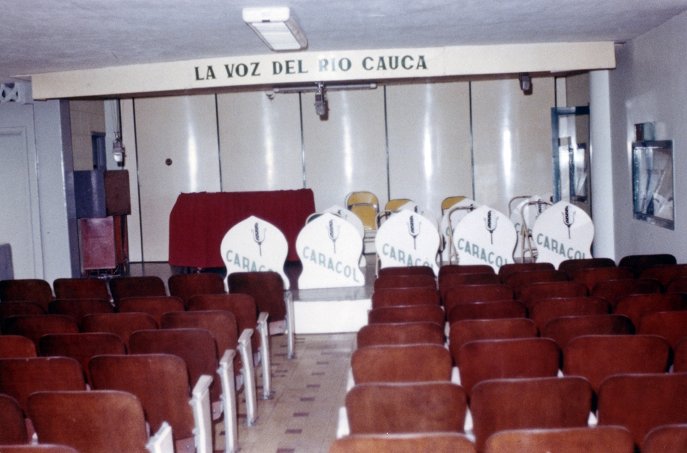Colombian Radio Stations |
|||
 |
Colombian Radio Stations
|
 |
|
|
|
|||
|
La Voz del Río Cauca, HJED
820 AM Cali |
|||
|
|
|||
|
HJED "Radioteatro" As one of the key stations of the CARACOL net, live broadcasts were often originated at HJED for all of Colombia. |
|||
 |
|||
|
On the way to the
HJED transmitter...
The HJED staff kindly took me to see the transmitter site, about 30 km North of Cali at Buga. This little incident delayed the arrival for a few minutes. |
|||
 |
|||
|
HJED AM Transmitter
site.
HJED was the only directional AM station in Colombia in 1963. The intent was to better cover the extremes of the Cauca River Valley, long and narrow. As a result, the station was widely heard in the USA in the 60's during silent periods of WBAP/WFAA in the Dallas market... my introduction to Colombian music was constant listening to "Una Voz en el Camino," the midnight to 5 AM truckers' show sponsored by the national truck manufacturer Colmotores. |
|||
 |
|||
|
Westinghouse 50 kw
main transmitter. CARACOL had modern, 50 kw transmitters in Cali, Medellín and Bogotá. A 1 kw auxiliary is to the right. |
|||
 |
|||
|
Directional
antenna array - HJED Rather than use a phaser, HJED simply ran two equal length open lines to the towers, allowing the spacing to achieve directionality. It worked. In fact, 5 years later I would build a similar system for a station in Ecuador. |
|||
 |
|||
|
Another view of the
directional antenna array - HJED A view from the base of one of the towers back towards the transmitter building. Equal transmission line length was achieved by having both lines travel to the mid point between towers, where one of them doubled back to the nearer tower. |
|||
 |
|||
|
Entrance to La Voz
de Antioquia In Medellín, CARACOL operated two stations, La Voz de Antioquia, the network affiliate, and Radio Reloj, a music station that gave the time every minute, even over records! Here is the Reloj street-view studio. |
|||
 |
|||
|
Transmitter site of Radio Pacífico de Cali on the highway to the
Cali airport. This was the principal station of the Radio Cadena Nacional (RCN) network in Colombia's third largest city. Owned at the time by industrial giant Coltejer, RCN operated multiple stations in each of the major markets. For more on RCN see http://es.wikipedia.org/wiki/RCN_Radio |
|||
 |
|||
|
Another of the
ubiquitous "radioteatros" As an important program origination point, La Voz de Antioquia had a full stdio for live broadcasts. |
|||
 |
|||
|
La Voz de
Antioquia Transmitter site. High above the valley where Medellín is situated was the AM transmitter for the station, operating on 750 kHz with 50,000 watts non-directional. |
|||
 |
|||
|
Tower, La Voz de
Antioquia Mid-1963. |
|||
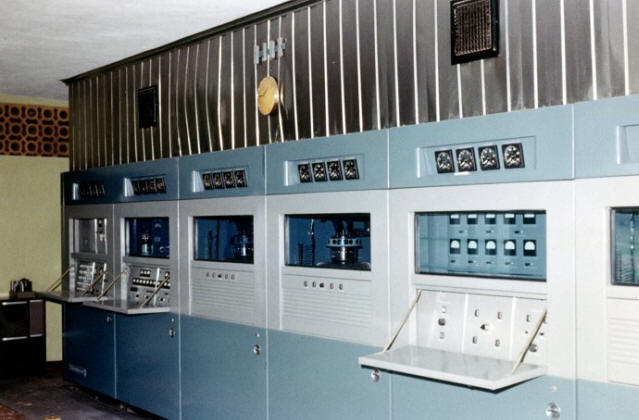 |
|||
|
Another
Westinghouse 50 kw transmitter, this time at
La Voz de Antioquia. |
|||
 |
|||
|
Bogotá - Emisora Nuevo Mundo CARACOL had its national headquarters in this building. 50,000 watt Nuevo Mundo was the flagship station for the CARACOL net, and the local radio Reloj 1100 AM was also here. In the 80's, CARACOL would buy the Catholic Church's Sutatenza network and move Nuevo Mundo (Later simply CARACOL-Bogotá) to 810 with 250,000 watts. Click here for CARACOL on the net. |
|||
 |
|||
|
Theater at Emisora
Nuevo Mundo.
Much of the live programming on CARACOL was originated in this studio, including "Los Tolimenses" and many other music and comedy shows. The stage is decorated for the program sponsored by Icasa, the national refrigerator manufacturer (note the product at the far left). |
|||
 |
|||
|
Radio Santa Fé -
Bogota. Lobby to 1070 AM station Radio Santa Fé (named after the full name of the city, Santa Fé de Bogotá) with the studio in the background. Radio Santa Fé enjoyed great success for many years by announcing taxi calls on the air in an era before radio taxis existed. Listeners called Santa Fé and taxi drivers could hear if there was a fare nearby, often occasioning a taxi traffic jam and consequent drivers fight when more than one taxi arrived for a single passenger! For a history of this pioneer station, click on the photo above. |
|||
 |
|||
|
Radio Santa Fé
live broadcast studio. Yet another radio theater. Santa Fé had theirs set up for local music groups as can be seen from the profusion of music stands. Live broadcasts of national music were made every evening. This station was also an early programmer of Colombian music such as cumbia and vallenata. |
|||
 |
|||
|
Radio Santa Fé
control room Note the ubiquitous Gates consoles of the era. These boards were found in a majority of larger, more modern stations in Latin America. |
|||
 |
|||
|
Radio Nutibara -
Medellín The top floor of the short building housed Radio Nutibara, a local AM on 1170 AM. |
|||
 |
|||
|
Nutibara Mobil
Unit - 1963 Note the two loudspeaker horns on the roof. |
|||
 |
|||
|
Raido Visión &
Radio Claridad - Medellín Visión was on 830 AM and Claridad on 1030, and were the affiliates of the Todelar net named after the founder and owner, Bernardo TObón DE LA Roche. |
|||
 |
|||
|
Radio Sinfonía -
Medellín 25,000 watt station on 910 AM. |
|||
 |
|||
|
Radio Ritmos -
Medellín Local music station on 1290 AM, a Colombian local channel at the time. The AM dial in Colombia was divided into regional (540-1000), provincial(100-1250) and local segments (1260-1600) with higher power stations on the lower frequencies and 1 kw limits on the ones over 1260 kHz. |
|||
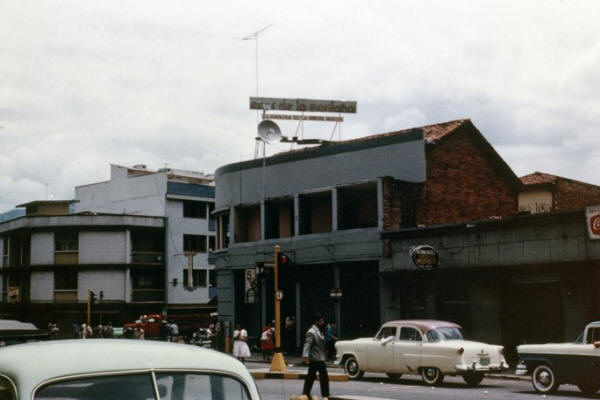 |
|||
| Ecos de la Montaña 790 AM Medellín | |||
 |
|||
|
Todelar - Cali Radio El Sol 900 and several other stations including radio Musical 980 were in this building. Todelar, an acronym based on the name of the owner, Jaiem TObón DE LA Roche, is one of the three major networks of the nation. More on Todelar at http://es.wikipedia.org/wiki/Todelar_Radio |
|||
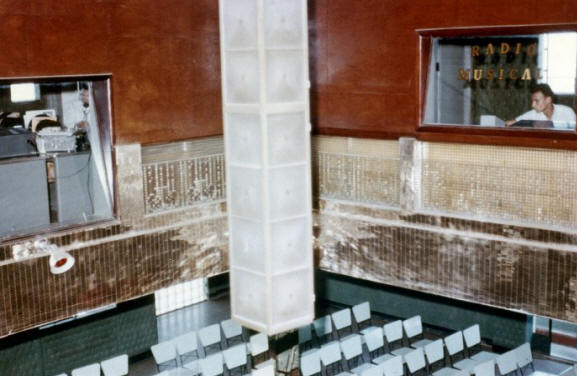 |
|||
|
Todelar - Cali Radio theater with studios positioned above the audience. |
|||
 |
|||
|
Radio Pacífico de
Cali 1020 AM facility was a part of RCN, the third and oldest of the Colombian national networks. Drive-by view of the transmitter site near the Cali airport. |
|||
 |
|||
| La Voz del Valle - Cali | |||
 |
|||
|
Radio Continental
- Bogotá RCN flagship station in Bogotá. This was the only station in normally hospitable Colombia where I was denied a tour. |
|||
 |
|||
| Studio - Radio Melodía 730 AM Bogotá | |||
 |
|||
| Announcer at Radio Melodía in Bogotá | |||
 |
|||
| Office staff - Radio Melodía | |||
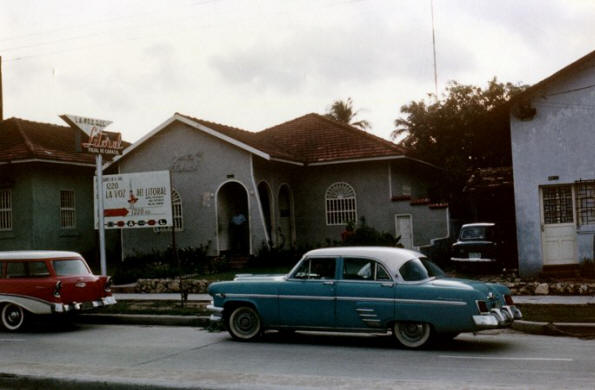 |
|||
|
CARACOL -
Barranquilla. Caracol had just expanded its Barranquilla operations and was building new facilities for La Voz del Litoral (The Voice of the Shoreline) on 1220 AM. They also operated Radio Reloj on 1100 AM. |
|||
 |
|||
|
La Voz de la Costa
- Barranquilla At this modern and new station, I was interviewed by Gabriel Forero Sanmiguel, the owner and renowned local radio journalist. Mr. Forrero had just installed this, his first station and was very proud to receive a "distinguished foreign broadcaster" I was 16 and had only been a part-time board operator! Here is an article about Mr. Forero Sanmiguel:
|
|||

